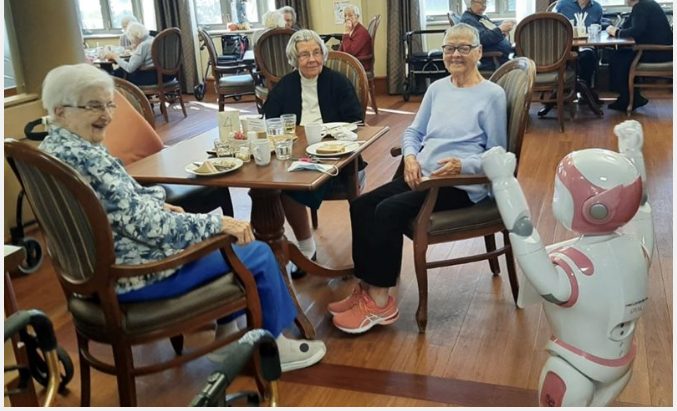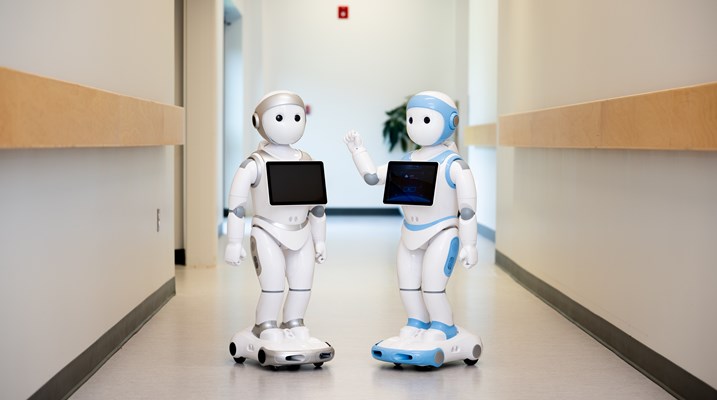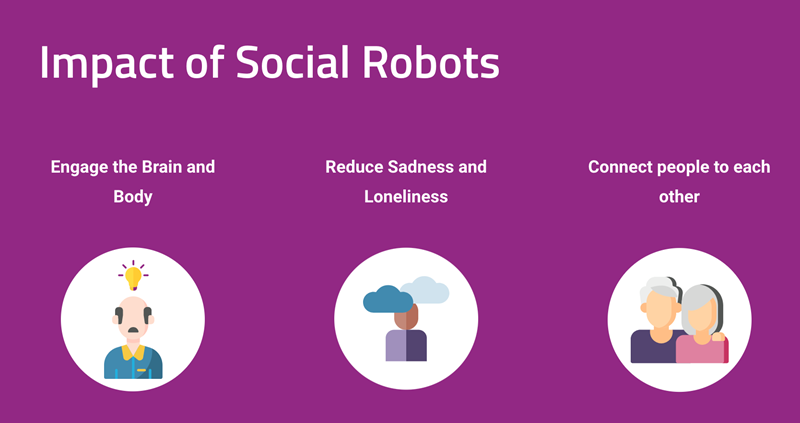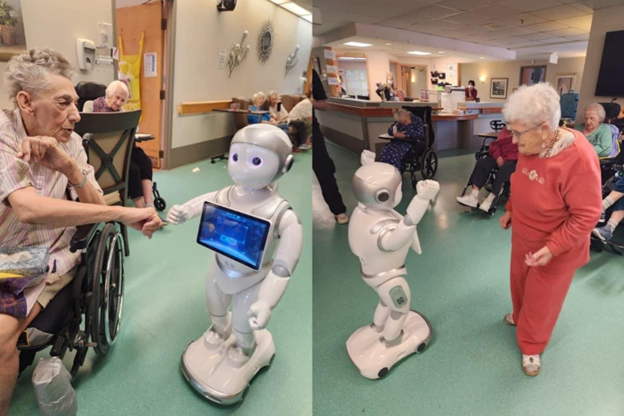The Social Robot Project

The Social Robot Project: Bridging the Loneliness Gap in Elder Care
Credit- Vanessa Tignanelli, Storyteller & Content Creator

Introduction
In the heart of Northern Ontario, a groundbreaking initiative is taking shape to address a critical issue in elder care: loneliness.
The Social Robot Project merges technology with human connection, aiming to enhance the lives of older adults in assisted living facilities. By integrating social robots and digital tools like iPads, this project explores innovative ways to foster connection and engagement, ultimately transforming the daily experiences of seniors and reducing feelings of isolation.
The Mission
Loneliness among seniors isn’t just a feeling—it’s a widespread issue with real consequences for health and happiness. The Social Robot Project aims to explore how advanced technology can help. By introducing humanoid robots and iPads into the daily routines of elderly residents, the project hopes to discover which method brings the most joy, interaction, and overall improvement to their lives.
“We want to determine whether the social companion robots improve social network, loneliness, and life satisfaction,” explains Anna-Liisa Mottonen, a Social Sciences Professor at Canadore College and Principal Investigator of the project. “To determine if those interactions measure above and beyond the improvements experienced by the control group, which engaged in similar activities but using only an iPad."
Thanks to the generous support of the community grant, Canadore College has launched an innovative pilot program in North Bay, Ontario, facilitating the acquisition of a state-of-the-art social robot.
The Team Behind the Project
Leading this innovative venture is a team of passionate individuals from diverse backgrounds. Anna-Liisa Mottonen and Rhiannon Buffett, a Recreation Therapy Professor at Canadore College, bring their expertise to the project, ensuring a robust and thoughtful approach. Lee St. James, the Founder of Social Robots Inc., provided the robots and training, while Canadore Research Centre staff, including Christina DeRoche, Omid Ali Kharazmi, and Siddharth M. Ramani, contributed their research skills.
NSERC Mobilize funds were used to expand the project and hire four students to support the college’s partners and older adult participants. The involvement of Kelsey Lecappelain from The Village and a dedicated group of four Canadore students added hands-on experience, including Neha Gulia, Sachindeep Singh, Sabrina Ratte, Sandhiya Chandiran, and Delaney Wohlert.
Neha Gulia, first-year student in the Social Service Worker program and one of the Student Research Assistants involved in the project, shares her experience: “The seniors are really excited about the robots, often copying their movements, dancing, and talking with them. Interacting with the robots is more than just a fun activity—it's a meaningful way for the residents to engage, reducing feelings of loneliness and bringing joy. The robots' features help create positive and uplifting experiences. The seniors truly enjoy interacting with the robots and appreciate everything they can do, making a real difference in their daily lives.”

The Approach
The project took place across multiple assisted living facilities throughout Northern Ontario over the course of eight weeks. Two older adult residences
Residents interacted with social robots—what can be seen as friendly, futuristic companions. These robots engaged residents in conversations, played games, and even facilitated video calls with family members.
“The inclusion of social robots and iPads allows them to try out new programs and to engage residents in new ways with the goal of targeting social and emotional well-being,” says Rhiannon Buffett. “Participants dancing and singing along to music that the social robots play brought laughter and joy to not only the residents, but to caregivers, the staff and the research team. Recreation Therapy program staff in long term care facilities continue to learn about new facilitation techniques and innovative programming to support the health and wellness of the residents they support.”
The Experience
The social robots have impacted both participants and researchers alike. Lee St. James reflects on the robots’ importance during outbreaks, or times when visitations are restricted: “Residents received photos and video messages from family members through a secure online portal connected to the robot’s display tablet, just one example of the ways in which the robots bring joy to isolated seniors.”
Participants’ responses to the robots varied, though the majority provided positive feedback. Some voiced their interactions with robots as having brought feelings of friendship and comfort. Others were less interested in engaging with technology but felt it improved feelings of unease using digital devices.
"I never thought I’d be interacting with robots at my age, but it’s been such a delightful experience,” says one participant. “They have added laughter to my days, and it's surprising how quickly we’ve all connected with them."
"What I love most is seeing the younger generation work with us through these robots,” says another, reflecting thoughtfully. “It reminds me that no matter the age gap, technology can bring us closer together. It’s been a heartwarming experience."
The Findings
The project set out to determine impact in several areas: loneliness, social engagement, and overall quality of life. Here’s what the research found:
- Loneliness: The robots seemed to have a special touch when it came to reducing loneliness. They provided a level of interaction that iPads cannot match. As Lee St. James suggests, “Social robots can augment the time spent by staff, volunteers, and family caregivers to provide additional activities that engage and entertain residents. Unlike a robotic vacuum or industrial robot that is used to execute repetitive tasks, SARs (or ‘socially-assistive robots’) can provide engaging interactions with people. They can be programmed to speak, move and respond to touch or simple verbal commands.
- Social Engagement: Both robots and iPads helped residents stay engaged, but the robots often led to more frequent interactions among residents themselves. According to Christina DeRoche, “The robots didn’t just interact with one person; they encouraged conversations and activities among groups of residents.”
- Quality of Life: While the robots and iPads both contributed to an improved quality of life, the robots provided a more personalized touch. However, iPads also showed promise, particularly in enhancing social networks and enabling virtual connections.

Looking Ahead
The Social Robot Project is just the beginning. The success of this pilot study suggests that technology can play a significant role in elder care.
The Government of Canada’s New Horizons for Seniors Program funding from Employment and Social Development Canada is supporting furthered expansion of the project into the Parry Sound District and creating local champions in both Nipissing and Parry Sound districts.
The team is eager to build on these findings and explore further:
- Expanding Technology Use: Exploring how different types of robots and digital tools can be used to support older adults in various settings.
- Enhancing Programming: Feedback from participants and caregivers will help refine the technology and programming to better meet the needs of seniors.
- Cultural and Linguistic Needs: The project has shown the importance of offering services in multiple languages. Future initiatives will continue to address diverse linguistic and cultural needs.
- Training and Education: Ongoing training for caregivers and student handlers will help ensure that they are well-prepared to use technology effectively.
- Community Outreach: The project’s success paves the way for broader implementation and outreach, bringing the benefits of social robots and digital tools to more communities.
Final Thoughts
The Social Robot Project is a testament to the power of innovation in improving elder care. By blending technology with human interaction, the project has shown that it’s possible to make a real difference in the lives of older adults. As the world continues to evolve, embracing these new tools and approaches can help create a future where no one has to face loneliness alone.
With a hopeful eye towards the future, the Social Robot Project stands as a possibility, showing that with creativity and compassion, technology can bridge the gap between loneliness and connection, one interaction at a time.

If you want to partner with us, Click Here.
If you're a student who wants to work with us, Click Here.

